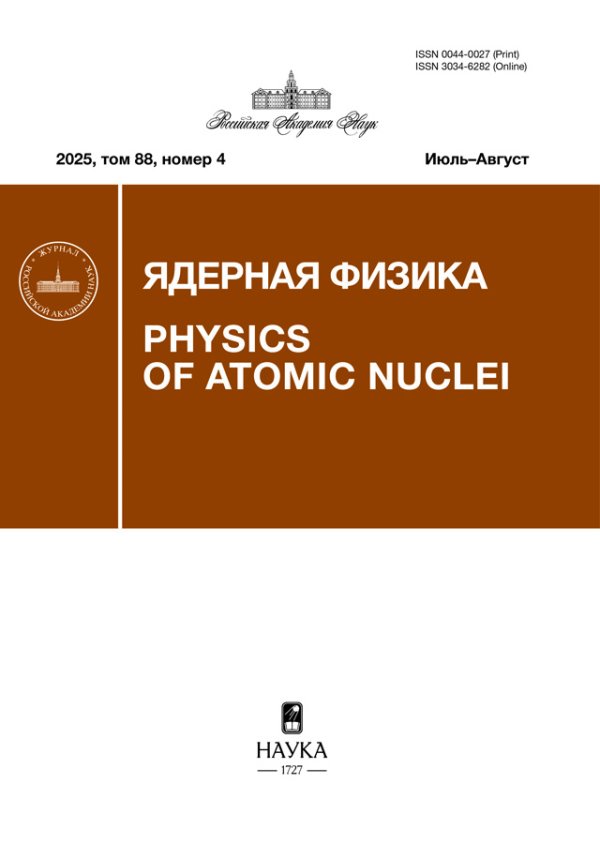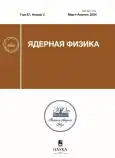Изучение космических лучей с энергией выше 5 ЭэВ радиометодом
- Авторы: Петров И.С.1, Кнуренко С.П.1
-
Учреждения:
- Институт космофизических исследований и аэрономии имени Ю.Г. Шафера СО РАН
- Выпуск: Том 87, № 2 (2024)
- Страницы: 79-85
- Раздел: ЭЛЕМЕНТАРНЫЕ ЧАСТИЦЫ И ПОЛЯ. Эксперимент
- Статья опубликована: 07.10.2024
- URL: https://gynecology.orscience.ru/0044-0027/article/view/674659
- DOI: https://doi.org/10.31857/S0044002724020029
- EDN: https://elibrary.ru/KRWDGO
- ID: 674659
Цитировать
Полный текст
Аннотация
На Якутской установке с 1986 г. было начато регулярное измерение радиоизлучения, генерируемое релятивистскими частицами ШАЛ. В результате изучения шумового поля в районе установки была выбрана частота регистрации 30–35 МГц, так как на этой частоте шумы были минимальными. За это время были зарегистрированы ливни с максимальными энергиями в 100 ЭэВ. Совместное изучение заряженных частиц, черенковского света ШАЛ и радиоизлучения показало, что амплитуда радиосигнала пропорциональна энергии ливня, а форма пространственного распределения радиоизлучения на уровне моря связана с максимумом развития каскада частиц ливня. По этим характеристикам с применением расчетов по модели QGSjetII-04 была дана оценка атомного веса первичных частиц, образующих ШАЛ.
Полный текст
Об авторах
И. С. Петров
Институт космофизических исследований и аэрономии имени Ю.Г. Шафера СО РАН
Автор, ответственный за переписку.
Email: igor.petrov@ikfia.ysn.ru
Россия, Якутск
С. П. Кнуренко
Институт космофизических исследований и аэрономии имени Ю.Г. Шафера СО РАН
Email: igor.petrov@ikfia.ysn.ru
Россия, Якутск
Список литературы
- А. Д. Филоненко, УФН 185, 673 (2015) [Phys. Usp. 58, 633 (2015)].
- В. А. Царев, ЭЧАЯ 35, 1 (2004).
- J. Linsley, Phys. Rev. Lett. 10, 146 (1963).
- J. V. Jelley, J. H. Fruin, N. A. Porter, T. C. Weekes, F. G. Smith, and R. A. Porter, Nature 205, 327 (1965).
- F. D. Kahn and I. Lerche, Proc. Roy. Soc. London Ser. A 289, 206 (1966).
- O. Scholten, K. Werner, and F. Rusydi, Astropart. Phys. 29, 94 (2008).
- G. A. Askaryan, Sov. Phys. JETP 14, 441 (1962).
- F. G. Schröder, Prog. Part. Nucl. Phys. 93, 1 (2017).
- V. P. Artamonov, T. A. Egorov, N. N. Efimov, T. V. Rekhlyasova, N. I. Sleptsov, S. A. Shudrya, and V. B. Atrashkevich, in Proceedings of the 21st ICRC, Adelaide, Australia (1990), Vol. 9, p. 210.
- L. G. Dedenko, A. V. Glushkov, S. P. Knurenko, I. T. Makarov, M. I. Pravdin, D. A. Podgrudkov, I. E. Sleptsov, T. M. Roganova, and G. F. Fedorova, JETP Lett. 90, 787 (2009).
- S. Knurenko, V. Kozlov, Z. Petrov, M. Pravdin, and A. Sabourov, in Proceedings of the 22nd ECRS, Turku, Finland (2010), p. 262.
- S. P. Knurenko, Z. E. Petrov, and I. S. Petrov, Nucl. Instum. Methods A 866, 230 (2017).
- Р. Р. Каримов, С. П. Кнуренко, В. И. Козлов, И. Т. Макаров, З. Е. Петров, М. И. Правдин, А. А. Торопов, Материалы XVI международного симпозиума (Томск, Россия, 2009), с. 602.
- S. P. Knurenko, D. S. Borschevsky, Z. E. Petrov, and I. S. Petrov, Proc. SPIE 8696, 86960Q (2012).
- С. П. Кнуренко, И. С. Петров, Письма в ЖЭТФ 104, 305 (2016).
- S. P. Knurenko, V. I. Kozlov, Z. E. Petrov, and M. I. Pravdin, Bull. Russ. Acad. Sci.: Phys. 77, 1559 (2013).
- A. Tikhonov and V. Arsenin, Solution of Ill-Posed Problems (Winston, New York, 1977), p. 258.
- M. N. Dyakonov, S. P. Knurenko, V. A. Kolosov, D. D. Krasilnikov, F. F. Lischenyuk, I. E. Sleptsov, and S. I. Nikolsky, Nucl. Instum. Methods A 248, 224 (1986).
- S. P. Knurenko, V. A. Kolosov, and Z. E. Petrov, in Proceedings of the 27th ICRC, Hamburg, Germany (2001), Vol. 1, p. 157.
- В. А. Кочнев, в Тр.: Применение ЭВМ в задачах управления (Красноярск, 1985. С. 62–71).
- М. Н. Дьяконов, С. П. Кнуренко, В. А. Колосов, И. Е. Слепцов, Оптика атмосферы и океана 12, 329 (1999).
- С. П. Кнуренко, И. С. Петров, Изв. РАН. Сер. физ. 79, 446 (2015).
- S. Ostapchenko, Phys. Rev. D 83, 014018 (2011).
- E. G. Berezhko, S. P. Knurenko, and L. T. Ksenofontov, Astropart. Phys. 36, 31 (2012).
- J. Hörandel, J. Phys.: Conf. Ser. 47, 41 (2006).
- S. Knurenko and I. Petrov, EPJ Web Conf. 208, 08017 (2019).
- R. U. Abbasi, M. Abe, T. Abu-Zayyad, M. Allen, R. Azuma, E. Barcikowski, J. W. Belz, D. R. Bergman, S. A. Blake, R. Cady, B. G. Cheon, J. Chiba, M. Chikawa, A. di Matteo, T. Fujii, K. Fujita, et al., Phys. Rev. D 99, 02002 (2019).
- J. Bellido, A. Aab, P. Abreu, M. Aglietta, I. Al Samarai, I. F. M. Albuquerque, I. Allekotte, A. Almela, J. Alvarez Castillo, J. Alvarez-Muñiz, G. A. Anastasi, L. Anchordoqui, B. Andrada, S. Andringa, C. Aramo, F. Arqueros, et al., Proc. Sci. 301, 506 (2018).
- S. P. Knurenko, L. T. Ksenofontov, and I. S. Petrov, Adv. Space Res. 70, 2767 (2022).
- J. N. Matthews, R. U. Abbasi, M. Abe, T. Abu-Zayyad, M. Allen, R. Azuma, E. Barcikowski, J. W. Belz, D. R. Bergman, S. A. Blake, R. Cady, B. G. Cheon, J. Chiba, M. Chikawa, A. di Matteo, T. Fujii, et al., Proc. Sci. 301, 1096 (2018).
Дополнительные файлы















